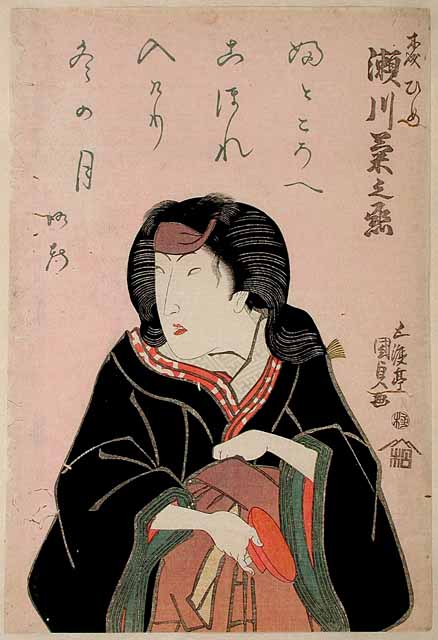
Segawa Kikunojo V as Morihime in Saruwaka hisago no gumbai (Saruwaka’s gourd-crested battle fan) performed at the Nakamura Theatre in 11/1820
Kunisada 20
Morihime’s long flowing hair and the wine cup in her hand show that she is inebriated.
Private collection
From an untitled set of half-length portraits on a pink ground, linked to the same performance.
Prints from a set depicting Saruwaka hisago no gumbai (Saruwaka’s gourd-crested battle fan) performed at the Nakamura Theatre in 11/1820
Private collection
Four prints from the series are displayed here, only two of which are known in other impressions. These were Kunisada’s first oban (standard-format) half-length portraits for four years, with the exception of fan portraits. In each print in this series, the subtlety of the printing in relation to the design is evident in the use of diluted black ink for the calligraphic strokes that define the kimono and sash as well as the actor’s name and role, the artist’s signature, the censor’s seal and the publisher’s mark. As an added refinement, the poem in the actor’s own hand is printed in colour set off by the delicate pink ground. This was the first time that a poem by the featured actor had been included on commercially issued actor-portraits. Such poems became a standard feature of Kunisada’s half-length actor portraits, and are found on 110 of the 200 portraits issued between 1820 and 1840 (although they are never encountered on commercially issued full-figure actor prints).
The Saruwaka in the title of the play is Saruwaka Kanzaburo, who was given official permission by the Shogun to open the Saruwaka Theatre (later renamed Nakamura when the family name changed), the first Kabuki theatre in Edo. The title thereby associates this performance with the Nakamura theatre. The ‘gourd-crest’ in the title belonged to the great warlord Hideyoshi, an indication that the play was one of the Taikoki mono (plays about the taiko), telling the story of the sixteenth-century warlord Hideyoshi, but with changed names. The identity of such historical characters was disguised to avoid infringing the ban on their portrayal on stage or in prints.
Loan 293

The female-role actor (onnagata) Segawa Kikunojo V c. 1822
Kunisada 4
Private collection
From a set of ten prints entitled Hotarugari Edokko soroi (Firefly catching a line-up of Edo folk), depicting actors in the roles of typical Edo characters dressed for a summer firefly hunt. This impression is from a limited deluxe printing. It is on thicker paper than usual and employs more subtle pigments than those encountered in standard commercially issued prints.
The nuances of printing enhance the impact of the graceful design, with its lilting sense of arrested motion. Particularly effective is the wiping of colour blocks to allow one colour to shade gradually into another. The purple patch covering Kikunojo V’s shaved pate and his coarse features identified him as a man, yet in dress and deportment he represented the essence of femininity.
The butterfly that decorates his fan is the identifying feature of the crest (mon) of the Kikunojo lineage of actors.
Loan 251
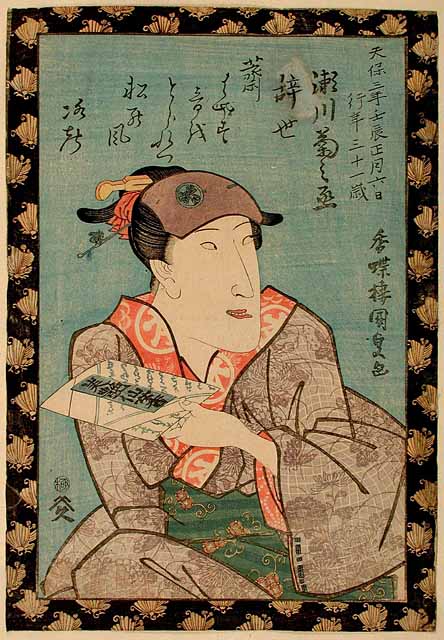
Memorial portrait (tsuizen-e) of Segawa Kikunojo V
01/1832
Kunisada 31
From the 1820s to 1860s memorial portraits featured regularly in the output of Edo publishers, many of them designed by Kunisada. He even produced more than one design of the same actor for competing publishers. The prints generally gave the actor’s stage name, date of death, age at the time of death, his ‘farewell poem’, funereal name, and the temple that would be entrusted with his remains. The deceased was depicted out of role sometimes in formal dress, sometimes in a Buddhist monk’s robes (or nun’s robes if they specialised in female-roles).
Whereas all other memorial prints of the 1820s and 30s showed the deceased full-figure (standing or seated), this print is exceptional in depicting the noted female-role actor (onnagata) Segawa Kikunojo V half-length. He is shown in female attire and simple woman’s coiffure with a square cloth covering his shaved forehead. Rather than holding the customary prayer beads, he is shown holding a packet of the leading face powder of the day. Such ‘product placement’ was rare in actor prints, but was often encountered in prints of beautiful women.
The stylised butterflies decorating the black frame of this print and ornamenting Kikunojo’s hairpin would have been recognised as the actor’s crest (mon) of Kikunojo; butterflies were also taken to represent the soul of the recently deceased.
Loan 214
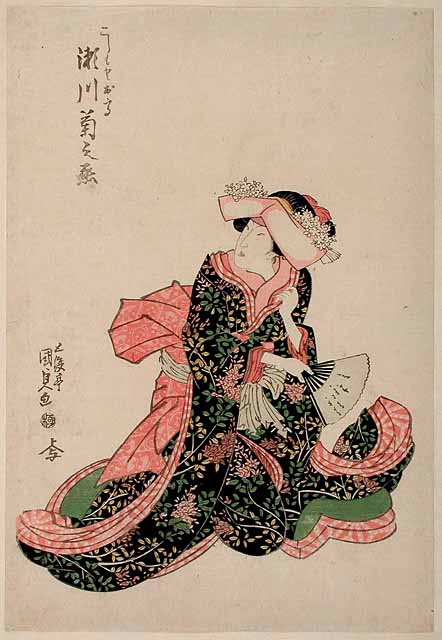
Segawa Kikunojo V as Koshimoto Otaka in the play Shiire Soga Karigane-zome (A new Soga Brothers design dyed in the Karigane Gang style) performed at the Nakamura Theatre in 01/1820
Kunisada 3
Private collection
This print is probably part of a triptych. It depicts a scene from one of the many plays performed at New Year based on the popular story of the revenge of the Soga brothers, in this case with a plot connected to that of the plays based on Karigane gonin otoko (Karigane’s ‘Five Chivalrous Men’ Gang), the story of the outlaw Karigane and his gang.
Loan 272
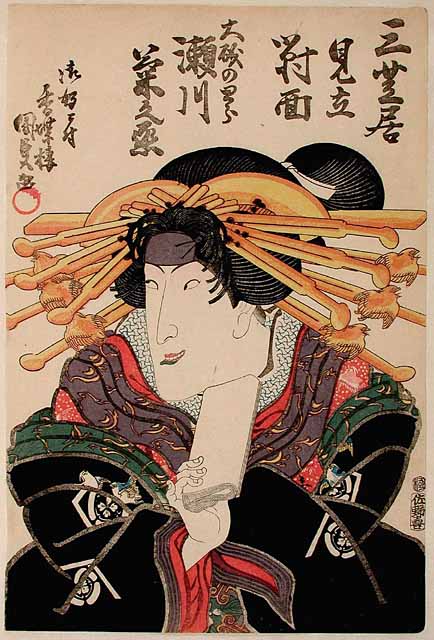
Segawa Kikunojo V as Oiso no Tora Gozen
Kunisada 12
c. 1831/2
Private Collection
Loan 310
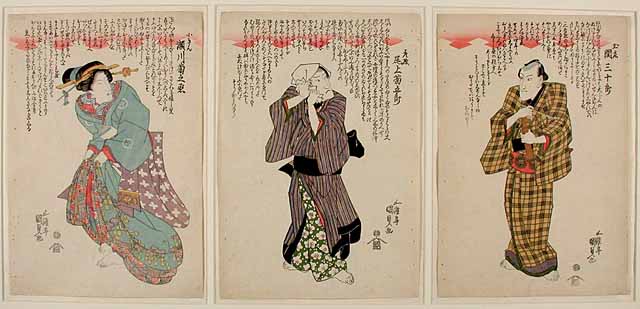
Seki Sanjuro as Tamasho (right), Onoe Kikugoro III as Hikoso (centre) and Segawa Kikunojo V as Kokin (left), in Hana-gumori sato no geta-kasa (Clogs and umbrellas in Yoshiwara on a cloudy day amidst cherry blossoms) performed at the Nakamura Theatre in 03/1824
Kunisada 0
Private collection (565)
This triptych captures the interplay between the three characters at a climactic moment in the play. The text around them records their dialogue in the scene, revealing that the geisha Kokin and her lover Hikoso are making their escape from the licensed quarters. Tamasho tries to dissuade couple from taking such a tragic course of action. In the mid 1820s there was a brief vogue for filling the background of half-length and full-figure actor portraits with extended texts (see also the diptych included in this exhibition). This device was derived from inexpensive, illustrated popular novels, in which text filled all the space around the figures. Kunisada was an experienced illustrator of such novels and often drew the characters with actors’ features.
Loan 565
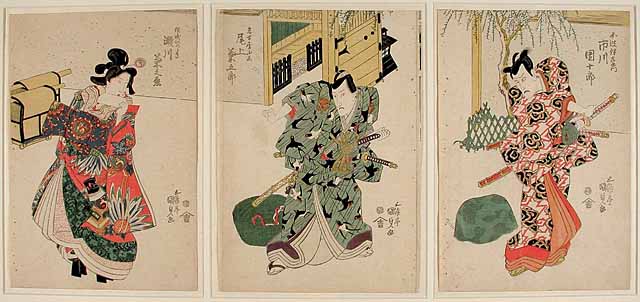
Ichikawa Danjuro VII as Fuwa Banzaemon (right), Onoe Kikugoro III as Nagoya Sanza (centre) and Segawa Kikunojo V as the courtesan Katsuragi (left) in Ukiyo-zuka hiyoku no inazuma (Ukiyo’s sword hilt, a double grave mound and the mark of the lightning bolt) performed at the Ichimura theatre in 03/1823
Kunisada 2
Private collection
This famous Saya-ate (‘Scabbards clashing’) confrontation scene occurs in the third act of the play, which was written for these performers and first performed in this production in 1823. The idea derived both from the established Kabuki convention of a Saya-ate scene, and from the 1807 novel by Santo Kyoden, Mukashi banashi inazuma hyoshi (An Old Time Lightning Bolt Tale). Fuwa Banzaemon carries a sword named ‘Thunder’ and wears a kimono decorated with a pattern of ‘lightning-in-the-clouds’. His rival Nagoya Sanzaburo (Sanza for short) carries a sword named ‘Amorous Swallows’ and wears a kimono decorated with a ‘swallows-in-the-rain’ pattern. Unaware of each other, they make simultaneous entrances along the two raised passageways (hanamichi) through the audience. As they pass on the main stage (which represents Nakano Street in the Yoshiwara pleasure district at cherry blossom time), their sword hilts clash. They exchange insults, remove their green sedge travelling-hats, recognize one another and draw swords to fight over the courtesan Katsuragi. Katsuragi rushes forward and persuades them to call a truce.
Loan 556
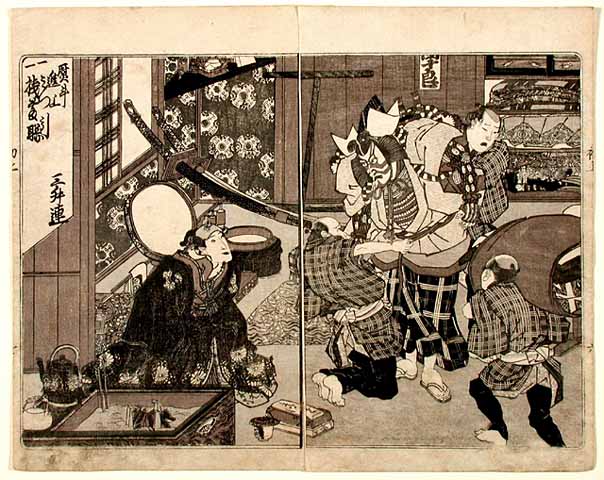
Yakusha kijinden (Biographies of eccentric actors)
Page from the book of this title, printed from woodblocks, 1833
Private collection
Ichikawa Danjuro VII is revealed here in his dressing room, chatting with the female-role actor Segawa Kikunojo V. Three assistants are dressing Danjuro in the bulky costume of the lead role of Kamakura Gongoro in Shibaraku! (Stop right there!). He has already put on the elaborate make-up required for the role. Two servants struggle to tighten his armour and jacket, while another servant on the right brings in the giant trousers (hakama). The great eight-foot sword that he will carry over his shoulder is seen resting against the wall behind him.
This book appeared in four volumes and provided meticulously rendered views of actors on and off stage, with a text discussing leading actors and their predecessors. It is remarkable for its restrained yet rich palette. A book like this would cost considerably more than a single-sheet colour print. It was intended for the wealthier connoisseurs of the Kabuki theatre.
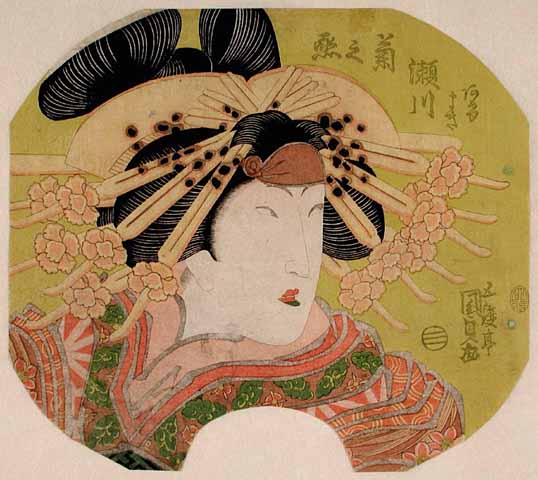
Segawa Kikunojo V
Kunisada 15
Segawa Kikunojo Vas Agemaki in Sukeroku yukari no Edo zakura (Sukeroku’s affinity for the cherry blossoms of Edo) performed at the Tamagawa Theatre in 1819
Private collection
Loan 406
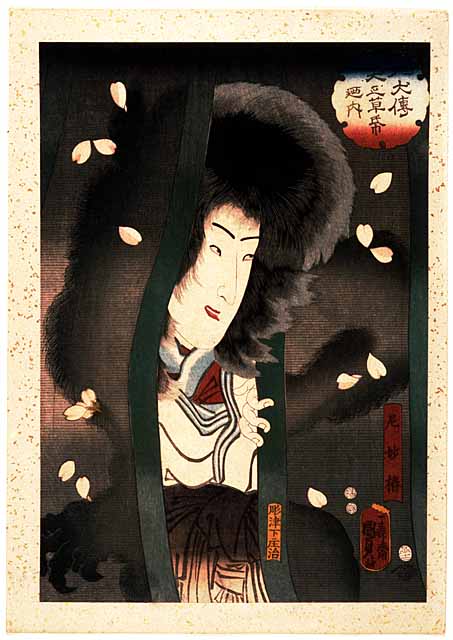
Utagawa Kunisada II (1823-80) {: .text-info } Kunisada 45
Ama Myochin (The nun Myochin)
10/1852
Given by the Friends of the Fitzwilliam with the aid of the MGC Purchase Grant Fund and the National Art Collections Fund.
Posthumous imaginary portrait of Segawa Kikunojo V as the racoon-dog spirit Myochin, from the series Hakkenden inu no soshi no uchi (Tale of the Eight Dogs). This series is perhaps the masterpiece of the artist formerly known as Kunimasa III, who changed his name to Kunisada II after becoming Kunisada’s son-in-law and one of his best pupils.Posthumous imaginary portrait of Segawa Kikunojo V as the racoon-dog spirit Myochin, from the series Hakkenden inu no soshi no uchi (Tale of the Eight Dogs). He sometimes collaborated on prints with Kunisada, as in the print of Goro Tokimune
Collections Record: P.68-1999
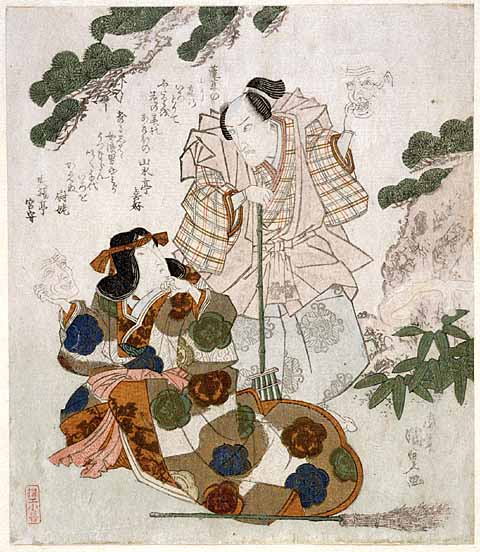
Ichikawa Danjuro VII as Jo and Segawa Kikunojo V] as Uba c. 1823-5
Kunisada 75
Given to the Fitzwilliam Museum by E. Evelyn Barron in 1937
A surimono showing a scene from a play based on the subject of the Eternal Couple from the Legend of Takasago. Jo and Uba were supposed to have fallen in love when young, and after living to a very old age their spirits came to abide in pine trees, one on the beach at Takasago in Harima, and the other at Sumiyoshi in Sesshu near Osaka. Their spirits returned on moonlit nights in human form with rakes to continue their work of clearing the pine needles on Takasago Beach. The legend inspired the No play Takasago, and was subsequently taken up by Kabuki, especially in the celebratory Takasago mono (Takasago dances), a line of celebratory dances, such as Takasago tanzen, premiered in 1785. In this print the actors are holding No masks.
The Eternal Couple were a popular subject in art. They are usually shown, Jo with a rake and Uba with a broom, sweeping pine needles, which symbolise longevity, an appropriate wish for surimono intended as New Year gifts.
The producer’s seal of Suriko Kozen appears on the print.
Collections Record: P.480-1937
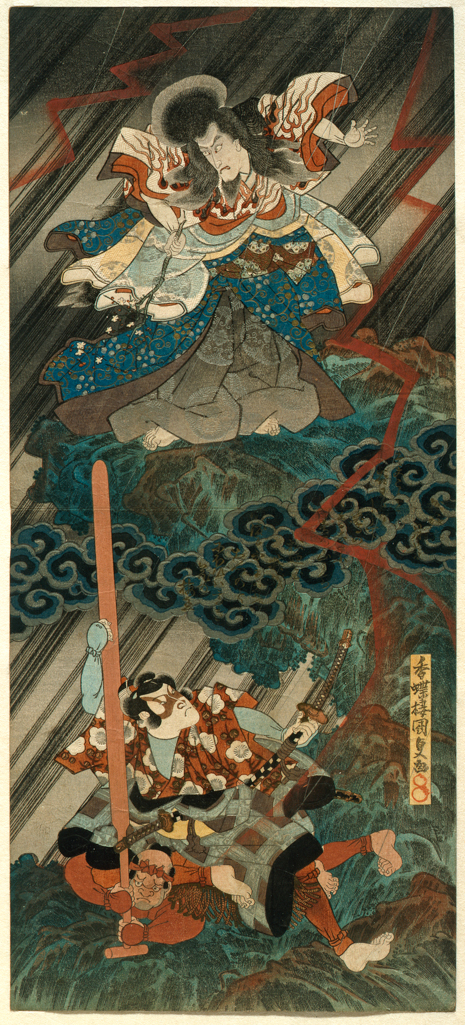
Ichikawa Danjuro VII as Kan Shojo (top) and Segawa Kikunojo V as Umeomaru (bottom) in Sugawara denju tenarai kagami (Sugawara and the secrets of calligraphy) performed at the Kawarazaki theatre in 09/1832
Kunisada 87
Given to the Fitzwilliam Museum by E. Evelyn Barron in 1937
Spring kyoka surimono commemorating the performance in the ninth month of 1832 at the Kawarazaki Theatre in Edo of Sugawara denju tenarai kagami (Sugawara and the secrets of calligraphy). The print shows the Tempaizan scene at Mount Tempai on Kyushu, where the exiled Sugawara, known as Kan Shojo, learns in a dream that his favourite plum tree from the garden in his home in Sada village has been moved to nearby Anraku Temple so that he may enjoy its blossoms. When he goes there he encounters one of his retainers, Umeomaru, involved in a duel. He breaks off a branch from the tree and magically decapitates Umeomaru’s opponent. He then learns from Umeomaru that his loss of position at court and subsequent exile are due to the machinations of his rival Shihei (Fujiwara Tokihira). Flying into a rage he turns into the Thunder god, raises a storm and, to the accompaniment of lightning, flies off to the capital (Kyoto) to muster support in preventing Shihei from gaining power.
The print conflates the scene of the duel with Kan Shojo’s transformation into the Thunder God. The poems include images of blossoms of plum (umeo), and Umeomaru’s jacket is decorated with the flower. Kan Shojo was one of Danjuro’s most celebrated roles. Almost twenty years earlier Kunisada designed a print of him in the role with the branch of plum blossom clenched between his teeth, in a set of ‘Great Performances’.
Collections Record: P.512-1937
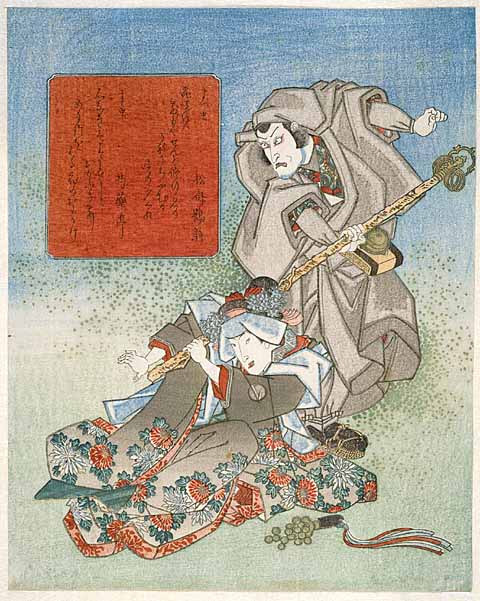
Ichikawa Danjuro VII as a pilgrim with Segawa Kikunojo V as a shrine dancer
Kunisada 76
c. 1823-5. Given to the Fitzwilliam Museum by E. Evelyn Barron in 1937
This unsigned surimono may be part of a diptych, with the signature on the missing right-hand sheet, and/or part of a series that involves comparisons with insects. Here the sound of the shrine dancer’s suzu bells (lying on the ground), and the ringed staff held by the pilgrim are compared to the sound of insects. The roles and play have yet to be identified.
Collections Record: P.517-1937



